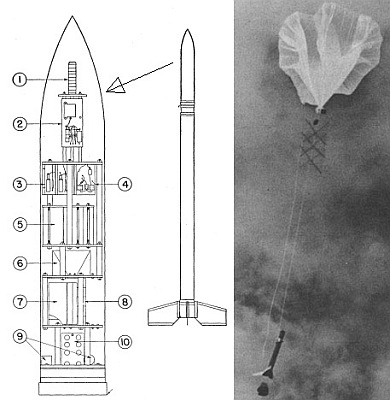Purpose of the flight and payload description
The so called ROCKOON (Rocket-Balloon) technique allowed small rockets to reach higher altitudes by sending it onboard a stratospheric balloon to an altitude of about 70.000 ft where it was fired either by an onboard timer, a pressure switch or by telecommand. The technique was first used in 1952 by Dr. James Van Allen then working at the State University of Iowa.
The main advantage of the rockoon combination was to let the rocket to pass throught the lower and thicker layers of the atmosphere without using its own propulsion power, which then allowed a higher apogee to be reched. The only setback was that once released, the balloons cannot be steered and consequently the rocket's launch direction nor imapct area can be predicted. Thus, for safety reasons, all the Rockoon missions were conducted from small vessels sailing in open waters. This possed an additional advantage as the ships could move with the wind to create a ""zero wind condition"" ideal to launch the balloons.
The first rockoon firings used a high-performance small vector known as DEACON. It was a vertically launched sounding rocket developed in 1947 by Allegany Balistics Laboratory for the Navy Bureau of Ordnance, and originally designed to carry a 50-pound instrument load to an altitude of about 20 miles. It had no internal controls or movable surfaces and was arrow stabillized by fins at the after end of the rocket. Propulsion was furnished by a JATO X220 solid propellant rocket motor. Its total length was 12.3 ft, diameter 6.5 inches and fin span was 38.9 inches. The Deacon was capable of attaining speeds about 3.000 mph, and altitudes in excess of 60 miles when fired from a balloon floating around 70.000 ft.
Details of the balloon flight
Balloon launched on: 7/20/1954
Launch site: USCGC Eastwind (WAGB 279)
Balloon launched by: General Mills Inc.
Balloon manufacturer/size/composition: Zero Pressure Balloon
End of flight (L for landing time, W for last contact, otherwise termination time): 7/20/1954
Landing site: Payload no recoverable
External references
- Deacon rocket launches log Jonathan McDowell's website
2628If you consider this website interesting or useful, you can help me to keep it up and running with a small donation to cover the operational costs. Just the equivalent of the price of a cup of coffee helps a lot.


